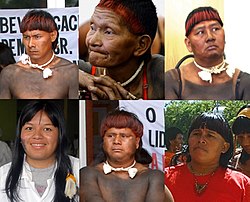Xavante
 | |
| Total population | |
|---|---|
| 30,000[1] | |
| Regions with significant populations | |
| Brazil | |
| Languages | |
| Xavante language |
TheXavante(alsoShavante,Chavante,Akuen,A'uwe,Akwe,Awen,orAkwen) are anindigenous people,comprising about 30,000 individuals[1]within the territory of easternMato Grossostate inBrazil.They speak theXavante language,part of theJê language family.
History
[edit]They wereenslavedin the 18th century,[2]after which they have tried to avoid contact. A temporary coexistence with westernized society in the 19th century in the state ofGoiás,[3]was followed by withdrawal toMato Grosso(between 1830 and 1860). They were "re-discovered" during the 1930s. From 1946 to 1957, they were brought underGetúlio Vargas'National Integration Program,but still experienced massacres and disease. Due to this history, they have a distrust of non-Xavante people. Today they are still wary of any approach of non-Xavante, called "waradzu".
The Xavante leaderMário Jurunawas the first indigenous Brazilian to become a federal representative.
The Xavante, like other indigenous tribes, were treated badly by the government beginning in the 1960s, the Xavante were moved from their homeland in Mato Grosso to a southern, malnourished area of Brazil. There, thousands of natives died due to disease, famine and warfare. Within the last decade, the Xavante have been relocated back to their original lands. Unfortunately, due to landgrabbing and squatters, the land was destroyed. Lush forest was burned to create sparse wasteland and pasture.[citation needed]
Genetic origins
[edit]A 2015 genetic study reached a surprising conclusion about the origins of the Xavante people. Unlike other Native American peoples, thePaiter-Surui,Karitiana,and Xavante have an ancestry partially related to indigenousAustralasianpopulations of theAndaman Islands,New Guinea,andAustralia.Scientists speculate that the relationship derives from an earlier people, called "Population Y",in EastAsiafrom whence both groups diverged 15,000 to 30,000 years ago, the future Australasians migrating south and the remote ancestors of the Xavante northward finding their way to the New World and to the interiorAmazon Basin.[4][5]
Culture
[edit]The people may be most famous for their dualistic societal structure. Two clans, the Âwawẽ and Po'reza'õno compose the culture, andmarriageis not allowed between members of the same clan. An example of inter-clan relationships are the traditional log races, where the two clans compete in a race to carrypalm treetrunks weighing as much as 80 kg to a defined point.
The Xavante are also known for their complex initiation rituals for youngmales,such as when small wooden sticks are inserted in theearlobesat the age of fourteen. As time passes, the size of these adornments is increased for the rest of their lives.
In 1996 the Brazilianheavy metalbandSepulturastayed and recorded with the Xavante people, who are featured on their albumRoots.A small number of Xavante even travelled to São Paulo to partake in Sepultura's Barulho Contra Fome (Noise Against Hunger) concert in 1998 that marked the start of their tour for their follow-up album,Against,where their presence was featured in the music video for the song "Choke".
Further reading
[edit]- Seth Garfield,Indigenous Struggle at the Heart of Brazil: State Policy, Frontier Expansion, and the Xavante Indians, 1937–1988,Duke University Press, 2001:ISBN0-8223-2665-5
- D.G.Fabré,Beyond the River of the Dead,Robert Hale Limited, London, 1963
- Roots (Sepultura album)- the Xavante tribe can be heard singing in the song "Itsari".
References
[edit]- ^ab"Localização e população atual".socioambiental.org.
- ^Giccaria, Bartolomeu. Xavante: Povo Autêntico. Editora Salesiana Dom Bosco, 1984, p. 29
- ^Giccaria, Bartolomeu. Xavante: Povo Autêntico. Editora Salesiana Dom Bosco, 1984, p. 35
- ^Skoglund, P.; Mallick, S.; Bortolini, M.C.; Chennagiri, N.; Hünemeier, T.;Petzl-Erler, M.L.;Salzano, F.M.; Patterson, N.;Reich, D.(21 July 2015)."Genetic evidence for two founding populations of the Americas".Nature.525(7567): 104–8.Bibcode:2015Natur.525..104S.doi:10.1038/nature14895.PMC4982469.PMID26196601.
- ^Skoglund, P.; Reich, D. (2016)."A genomic view of the peopling of the Americas".Current Opinion in Genetics & Development.41:27–35.doi:10.1016/j.gde.2016.06.016.PMC5161672.PMID27507099.
External links
[edit]- Instituto Socioambiental Encyclopedia of Indigenous Peoples of Brazil
- Xavanteentry atSIL International
- Great Web of Percy Harrison Fawcett
- Cultural Survival:David Maybury-Lewis, Xavante Archive Documents Vital CultureLaura Graham, Effects of Modernization on the Xavante
- https://archive.org/details/WAIA_Part2_J_2004 Rites of the Xavante
